Scope and Time Management Plan
VerifiedAdded on 2023/01/16
|11
|1660
|69
AI Summary
The goal of the project is to construct a Bunglow within estimated time period and allotted project budget considering the demand of the consumers and other specifications. The Bunglow will be constructed on the strip footings.
Contribute Materials
Your contribution can guide someone’s learning journey. Share your
documents today.

Running head: SCOPE AND TIME MANAGEMENT PLAN
Scope and Time Management Plan: The Bungalow Project
Name of the student:
Name of the University:
Scope and Time Management Plan: The Bungalow Project
Name of the student:
Name of the University:
Secure Best Marks with AI Grader
Need help grading? Try our AI Grader for instant feedback on your assignments.
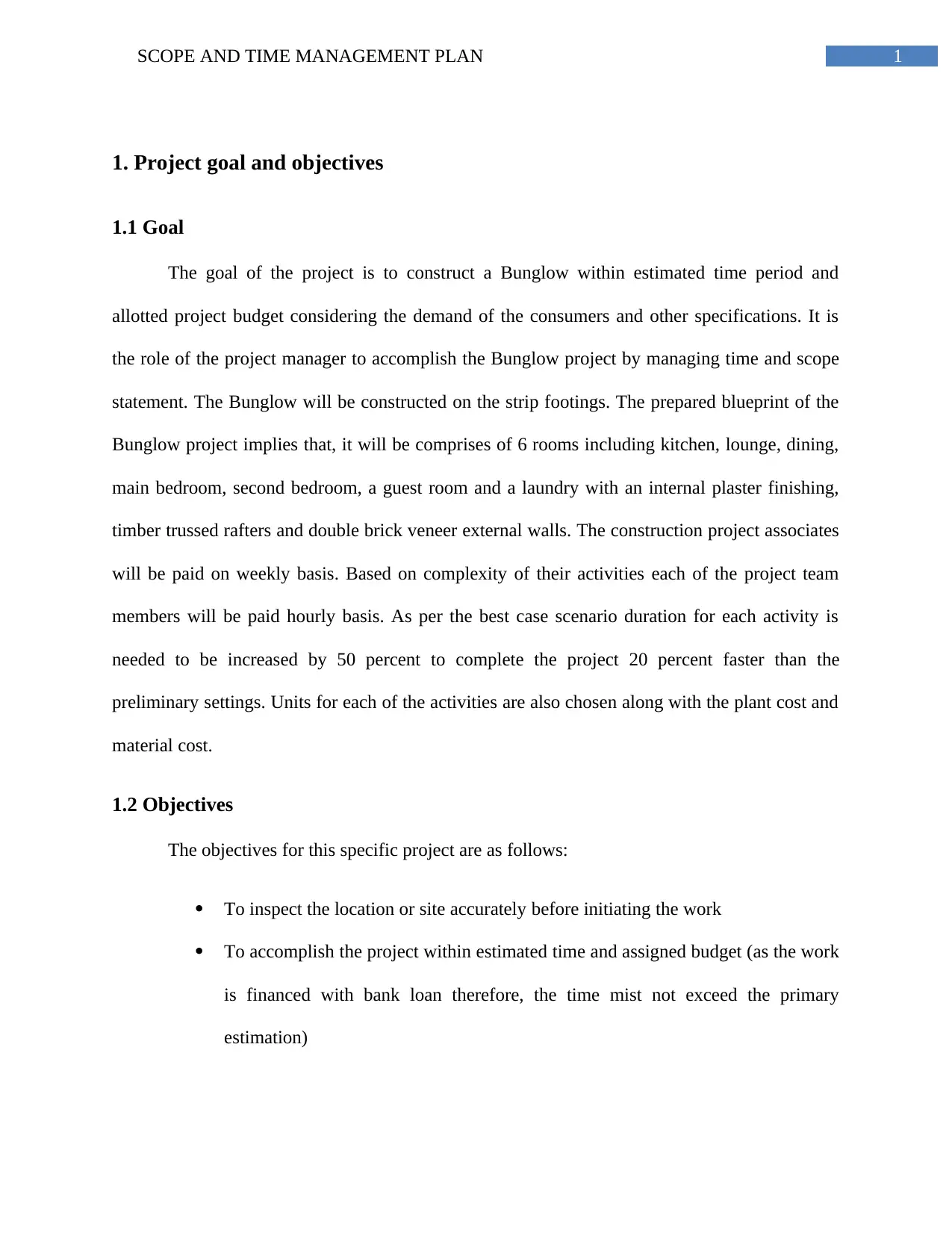
1SCOPE AND TIME MANAGEMENT PLAN
1. Project goal and objectives
1.1 Goal
The goal of the project is to construct a Bunglow within estimated time period and
allotted project budget considering the demand of the consumers and other specifications. It is
the role of the project manager to accomplish the Bunglow project by managing time and scope
statement. The Bunglow will be constructed on the strip footings. The prepared blueprint of the
Bunglow project implies that, it will be comprises of 6 rooms including kitchen, lounge, dining,
main bedroom, second bedroom, a guest room and a laundry with an internal plaster finishing,
timber trussed rafters and double brick veneer external walls. The construction project associates
will be paid on weekly basis. Based on complexity of their activities each of the project team
members will be paid hourly basis. As per the best case scenario duration for each activity is
needed to be increased by 50 percent to complete the project 20 percent faster than the
preliminary settings. Units for each of the activities are also chosen along with the plant cost and
material cost.
1.2 Objectives
The objectives for this specific project are as follows:
To inspect the location or site accurately before initiating the work
To accomplish the project within estimated time and assigned budget (as the work
is financed with bank loan therefore, the time mist not exceed the primary
estimation)
1. Project goal and objectives
1.1 Goal
The goal of the project is to construct a Bunglow within estimated time period and
allotted project budget considering the demand of the consumers and other specifications. It is
the role of the project manager to accomplish the Bunglow project by managing time and scope
statement. The Bunglow will be constructed on the strip footings. The prepared blueprint of the
Bunglow project implies that, it will be comprises of 6 rooms including kitchen, lounge, dining,
main bedroom, second bedroom, a guest room and a laundry with an internal plaster finishing,
timber trussed rafters and double brick veneer external walls. The construction project associates
will be paid on weekly basis. Based on complexity of their activities each of the project team
members will be paid hourly basis. As per the best case scenario duration for each activity is
needed to be increased by 50 percent to complete the project 20 percent faster than the
preliminary settings. Units for each of the activities are also chosen along with the plant cost and
material cost.
1.2 Objectives
The objectives for this specific project are as follows:
To inspect the location or site accurately before initiating the work
To accomplish the project within estimated time and assigned budget (as the work
is financed with bank loan therefore, the time mist not exceed the primary
estimation)
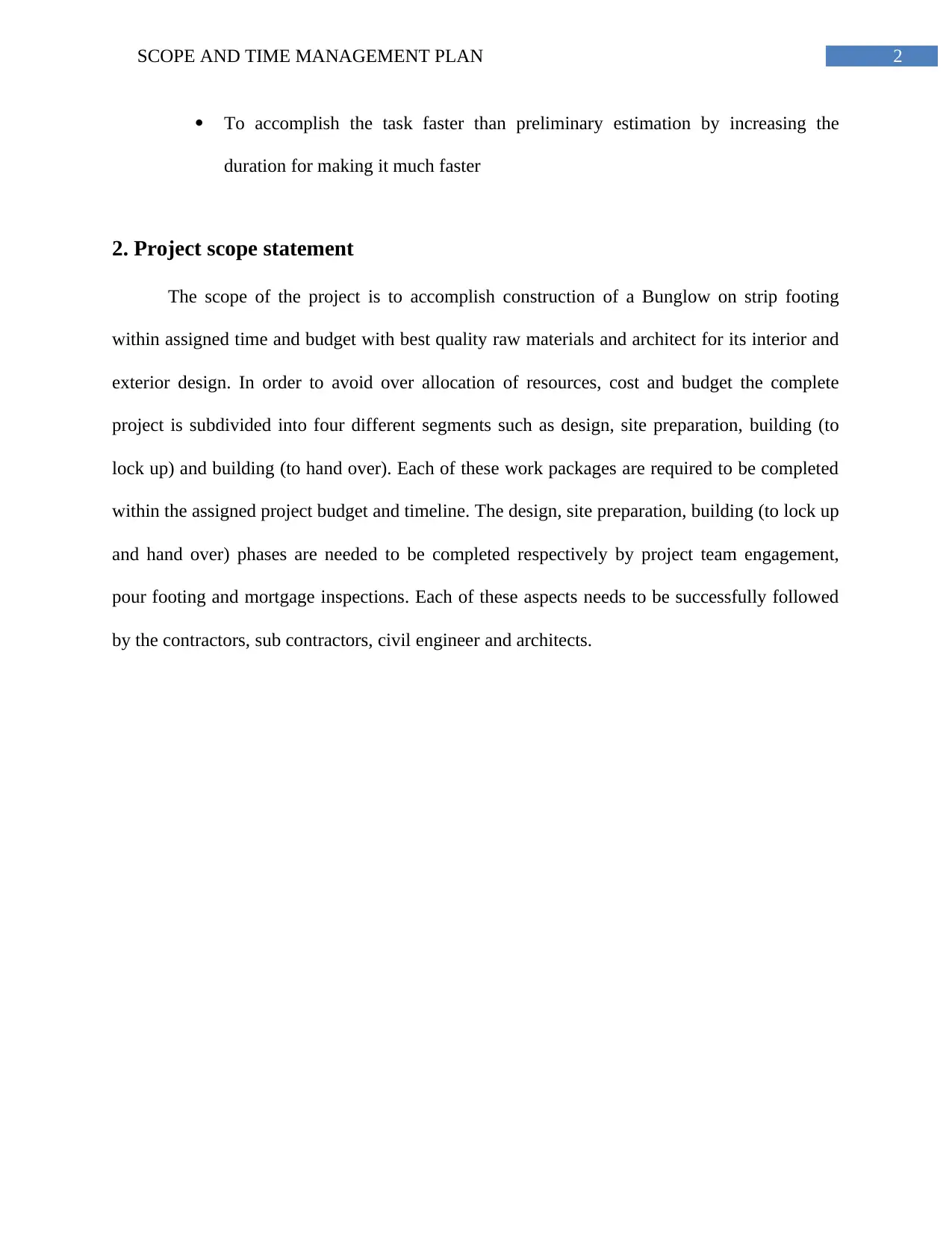
2SCOPE AND TIME MANAGEMENT PLAN
To accomplish the task faster than preliminary estimation by increasing the
duration for making it much faster
2. Project scope statement
The scope of the project is to accomplish construction of a Bunglow on strip footing
within assigned time and budget with best quality raw materials and architect for its interior and
exterior design. In order to avoid over allocation of resources, cost and budget the complete
project is subdivided into four different segments such as design, site preparation, building (to
lock up) and building (to hand over). Each of these work packages are required to be completed
within the assigned project budget and timeline. The design, site preparation, building (to lock up
and hand over) phases are needed to be completed respectively by project team engagement,
pour footing and mortgage inspections. Each of these aspects needs to be successfully followed
by the contractors, sub contractors, civil engineer and architects.
To accomplish the task faster than preliminary estimation by increasing the
duration for making it much faster
2. Project scope statement
The scope of the project is to accomplish construction of a Bunglow on strip footing
within assigned time and budget with best quality raw materials and architect for its interior and
exterior design. In order to avoid over allocation of resources, cost and budget the complete
project is subdivided into four different segments such as design, site preparation, building (to
lock up) and building (to hand over). Each of these work packages are required to be completed
within the assigned project budget and timeline. The design, site preparation, building (to lock up
and hand over) phases are needed to be completed respectively by project team engagement,
pour footing and mortgage inspections. Each of these aspects needs to be successfully followed
by the contractors, sub contractors, civil engineer and architects.
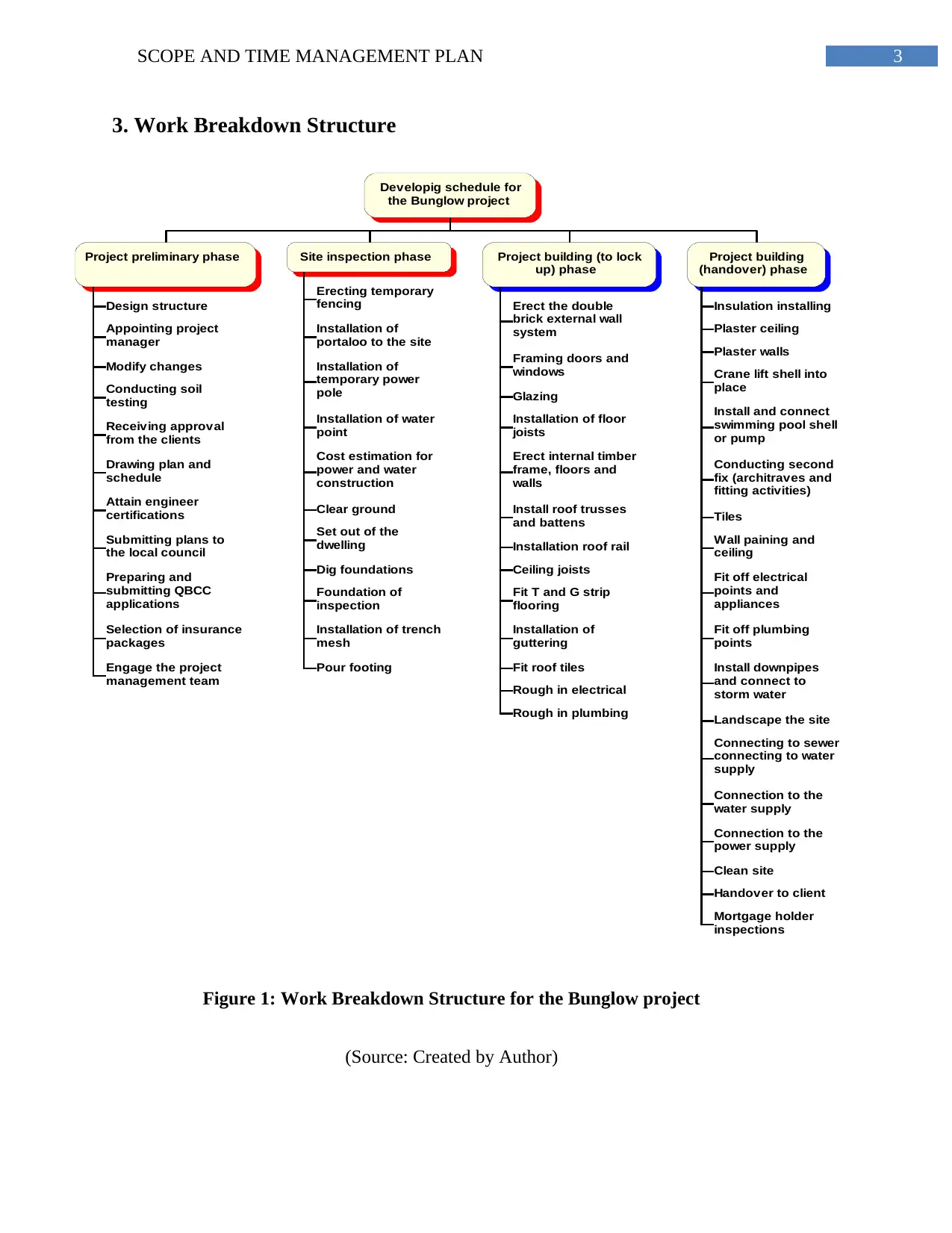
3SCOPE AND TIME MANAGEMENT PLAN
3. Work Breakdown Structure
Developig schedule for
the Bunglow project
Project preliminary phase
Design structure
Appointing project
manager
Modify changes
Conducting soil
testing
Receiving approval
from the clients
Drawing plan and
schedule
Attain engineer
certifications
Submitting plans to
the local council
Preparing and
submitting QBCC
applications
Selection of insurance
packages
Engage the project
management team
Site inspection phase
Erecting temporary
fencing
Installation of
portaloo to the site
Installation of
temporary power
pole
Installation of water
point
Cost estimation for
power and water
construction
Clear ground
Set out of the
dwelling
Dig foundations
Foundation of
inspection
Installation of trench
mesh
Pour footing
Project building (to lock
up) phase
Erect the double
brick external wall
system
Framing doors and
windows
Glazing
Installation of floor
joists
Erect internal timber
frame, floors and
walls
Install roof trusses
and battens
Installation roof rail
Ceiling joists
Fit T and G strip
flooring
Installation of
guttering
Fit roof tiles
Rough in electrical
Rough in plumbing
Project building
(handover) phase
Insulation installing
Plaster ceiling
Plaster walls
Crane lift shell into
place
Install and connect
swimming pool shell
or pump
Conducting second
fix (architraves and
fitting activities)
Tiles
Wall paining and
ceiling
Fit off electrical
points and
appliances
Fit off plumbing
points
Install downpipes
and connect to
storm water
Landscape the site
Connecting to sewer
connecting to water
supply
Connection to the
water supply
Connection to the
power supply
Clean site
Handover to client
Mortgage holder
inspections
Figure 1: Work Breakdown Structure for the Bunglow project
(Source: Created by Author)
3. Work Breakdown Structure
Developig schedule for
the Bunglow project
Project preliminary phase
Design structure
Appointing project
manager
Modify changes
Conducting soil
testing
Receiving approval
from the clients
Drawing plan and
schedule
Attain engineer
certifications
Submitting plans to
the local council
Preparing and
submitting QBCC
applications
Selection of insurance
packages
Engage the project
management team
Site inspection phase
Erecting temporary
fencing
Installation of
portaloo to the site
Installation of
temporary power
pole
Installation of water
point
Cost estimation for
power and water
construction
Clear ground
Set out of the
dwelling
Dig foundations
Foundation of
inspection
Installation of trench
mesh
Pour footing
Project building (to lock
up) phase
Erect the double
brick external wall
system
Framing doors and
windows
Glazing
Installation of floor
joists
Erect internal timber
frame, floors and
walls
Install roof trusses
and battens
Installation roof rail
Ceiling joists
Fit T and G strip
flooring
Installation of
guttering
Fit roof tiles
Rough in electrical
Rough in plumbing
Project building
(handover) phase
Insulation installing
Plaster ceiling
Plaster walls
Crane lift shell into
place
Install and connect
swimming pool shell
or pump
Conducting second
fix (architraves and
fitting activities)
Tiles
Wall paining and
ceiling
Fit off electrical
points and
appliances
Fit off plumbing
points
Install downpipes
and connect to
storm water
Landscape the site
Connecting to sewer
connecting to water
supply
Connection to the
water supply
Connection to the
power supply
Clean site
Handover to client
Mortgage holder
inspections
Figure 1: Work Breakdown Structure for the Bunglow project
(Source: Created by Author)
Secure Best Marks with AI Grader
Need help grading? Try our AI Grader for instant feedback on your assignments.

4SCOPE AND TIME MANAGEMENT PLAN
4. Project schedule
WBS Task Name Duration
0 Developing schedule for the Bunglow project 420 days
1 Project preliminary phase 357 days
1.1 Design structure 14 days
1.2 Appointing project manager 336 days
1.3 Modify changes 7 days
1.4 Conducting soil testing 14 days
1.5 Receiving approval from the clients 7 days
1.6 Drawing plan and schedule 14 days
1.7 Attain engineer certifications 14 days
1.8 Submitting plans to the local council 42 days
1.9 Preparing and submitting QBCC applications 7 days
1.10 Selection of insurance packages 14 days
1.11 Engage the project management team 266 days
2 Site inspection phase 343 days
2.1 Erecting temporary fencing 7 days
2.2 Installation of portaloo to the site 336 days
2.3 Installation of temporary power pole 7 days
2.4 Installation of water point 7 days
2.5 Cost estimation for power and water construction 7 days
2.6 Clear ground 7 days
2.7 Set out of the dwelling 7 days
2.8 Dig foundations 21 days
2.9 Foundation of inspection 7 days
2.10 Installation of trench mesh 7 days
2.11 Pour footing 7 days
3 Project building (to lock up) phase 94.5 days
3.1 Erect the double brick external wall system 21 days
3.2 Framing doors and windows 7 days
3.3 Glazing 7 days
3.4 Installation of floor joists 7 days
3.5 Erect internal timber frame, floors and walls 21 days
3.6 Install roof trusses and battens 21 days
3.7 Installation roof rail 17.5 days
3.8 Ceiling joists 7 days
3.9 Fit T and G strip flooring 7 days
3.10 Installation of guttering 7 days
3.11 Fit roof tiles 14 days
4. Project schedule
WBS Task Name Duration
0 Developing schedule for the Bunglow project 420 days
1 Project preliminary phase 357 days
1.1 Design structure 14 days
1.2 Appointing project manager 336 days
1.3 Modify changes 7 days
1.4 Conducting soil testing 14 days
1.5 Receiving approval from the clients 7 days
1.6 Drawing plan and schedule 14 days
1.7 Attain engineer certifications 14 days
1.8 Submitting plans to the local council 42 days
1.9 Preparing and submitting QBCC applications 7 days
1.10 Selection of insurance packages 14 days
1.11 Engage the project management team 266 days
2 Site inspection phase 343 days
2.1 Erecting temporary fencing 7 days
2.2 Installation of portaloo to the site 336 days
2.3 Installation of temporary power pole 7 days
2.4 Installation of water point 7 days
2.5 Cost estimation for power and water construction 7 days
2.6 Clear ground 7 days
2.7 Set out of the dwelling 7 days
2.8 Dig foundations 21 days
2.9 Foundation of inspection 7 days
2.10 Installation of trench mesh 7 days
2.11 Pour footing 7 days
3 Project building (to lock up) phase 94.5 days
3.1 Erect the double brick external wall system 21 days
3.2 Framing doors and windows 7 days
3.3 Glazing 7 days
3.4 Installation of floor joists 7 days
3.5 Erect internal timber frame, floors and walls 21 days
3.6 Install roof trusses and battens 21 days
3.7 Installation roof rail 17.5 days
3.8 Ceiling joists 7 days
3.9 Fit T and G strip flooring 7 days
3.10 Installation of guttering 7 days
3.11 Fit roof tiles 14 days
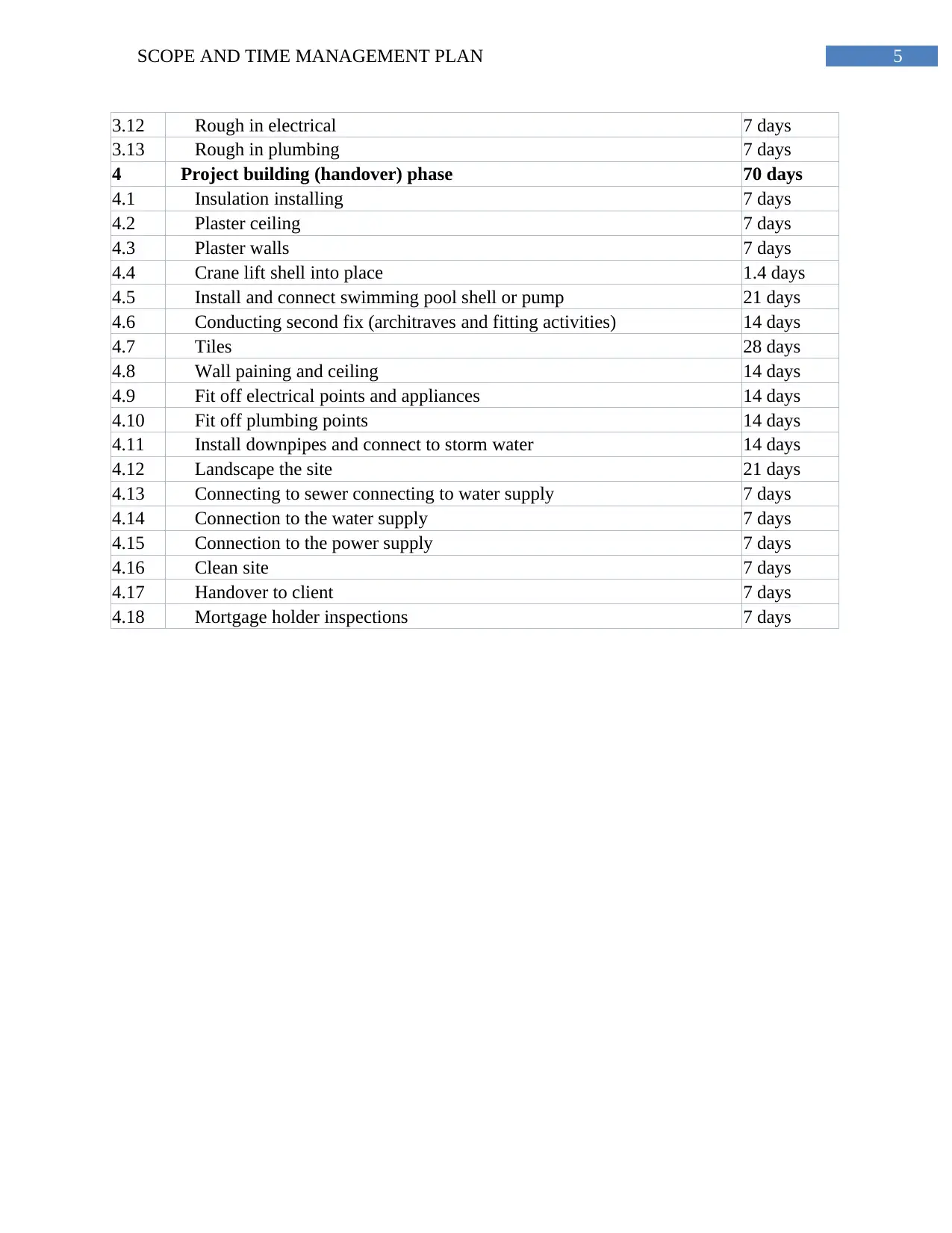
5SCOPE AND TIME MANAGEMENT PLAN
3.12 Rough in electrical 7 days
3.13 Rough in plumbing 7 days
4 Project building (handover) phase 70 days
4.1 Insulation installing 7 days
4.2 Plaster ceiling 7 days
4.3 Plaster walls 7 days
4.4 Crane lift shell into place 1.4 days
4.5 Install and connect swimming pool shell or pump 21 days
4.6 Conducting second fix (architraves and fitting activities) 14 days
4.7 Tiles 28 days
4.8 Wall paining and ceiling 14 days
4.9 Fit off electrical points and appliances 14 days
4.10 Fit off plumbing points 14 days
4.11 Install downpipes and connect to storm water 14 days
4.12 Landscape the site 21 days
4.13 Connecting to sewer connecting to water supply 7 days
4.14 Connection to the water supply 7 days
4.15 Connection to the power supply 7 days
4.16 Clean site 7 days
4.17 Handover to client 7 days
4.18 Mortgage holder inspections 7 days
3.12 Rough in electrical 7 days
3.13 Rough in plumbing 7 days
4 Project building (handover) phase 70 days
4.1 Insulation installing 7 days
4.2 Plaster ceiling 7 days
4.3 Plaster walls 7 days
4.4 Crane lift shell into place 1.4 days
4.5 Install and connect swimming pool shell or pump 21 days
4.6 Conducting second fix (architraves and fitting activities) 14 days
4.7 Tiles 28 days
4.8 Wall paining and ceiling 14 days
4.9 Fit off electrical points and appliances 14 days
4.10 Fit off plumbing points 14 days
4.11 Install downpipes and connect to storm water 14 days
4.12 Landscape the site 21 days
4.13 Connecting to sewer connecting to water supply 7 days
4.14 Connection to the water supply 7 days
4.15 Connection to the power supply 7 days
4.16 Clean site 7 days
4.17 Handover to client 7 days
4.18 Mortgage holder inspections 7 days

6SCOPE AND TIME MANAGEMENT PLAN
Figure 2: Schedule prepared for the Bunglow Project
(Source: created by author)
Figure 2: Schedule prepared for the Bunglow Project
(Source: created by author)
Paraphrase This Document
Need a fresh take? Get an instant paraphrase of this document with our AI Paraphraser
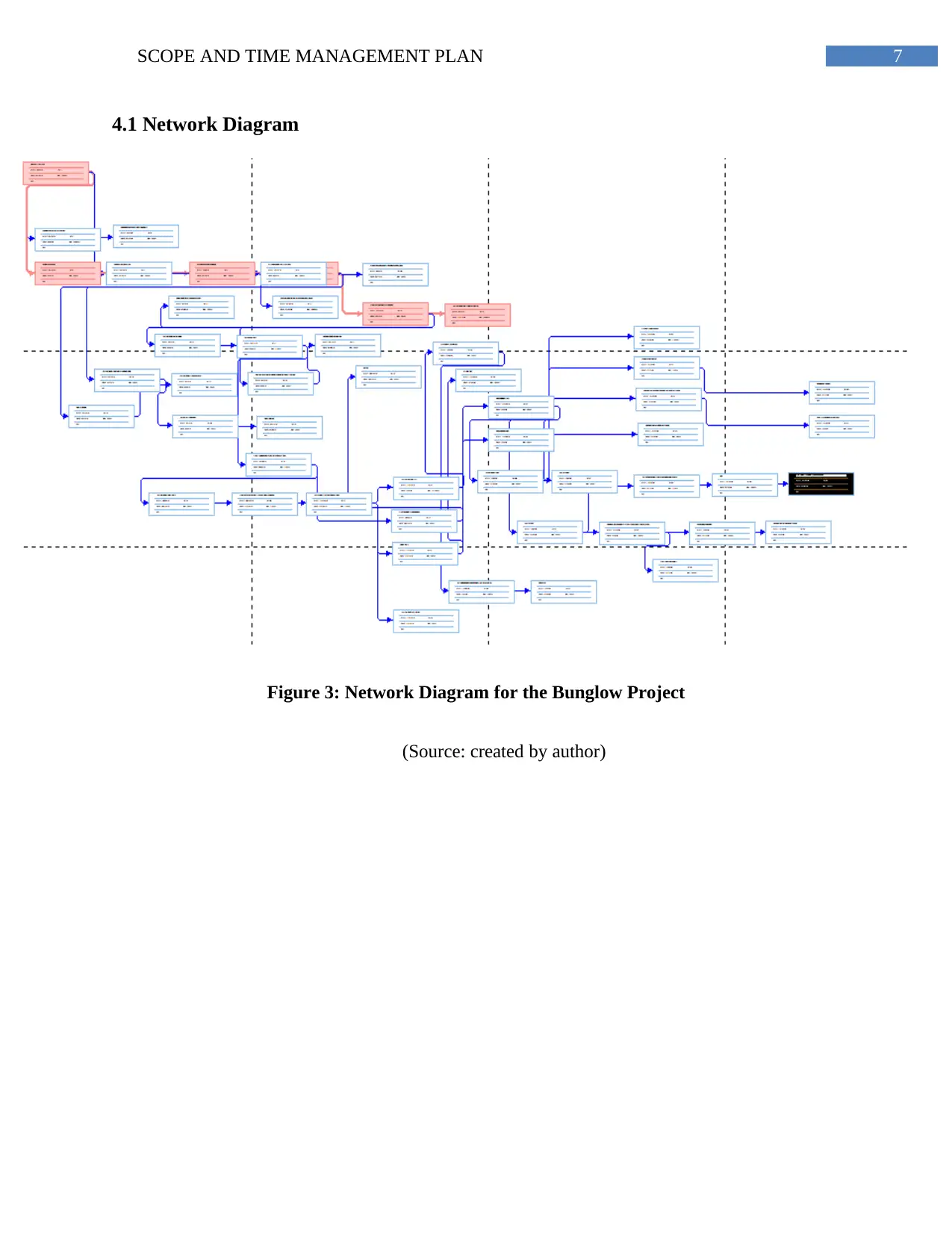
7SCOPE AND TIME MANAGEMENT PLAN
4.1 Network Diagram
Figure 3: Network Diagram for the Bunglow Project
(Source: created by author)
4.1 Network Diagram
Figure 3: Network Diagram for the Bunglow Project
(Source: created by author)
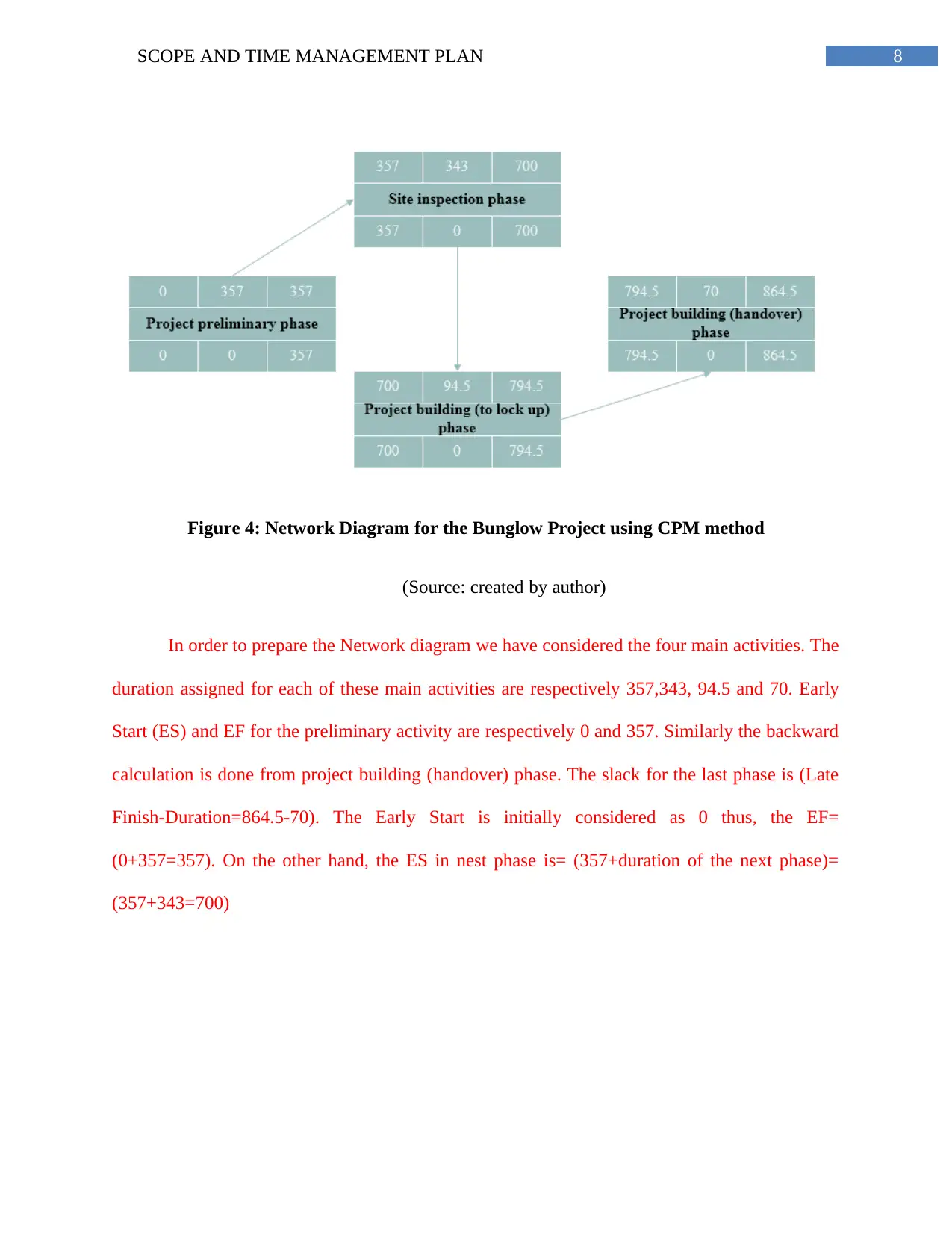
8SCOPE AND TIME MANAGEMENT PLAN
Figure 4: Network Diagram for the Bunglow Project using CPM method
(Source: created by author)
In order to prepare the Network diagram we have considered the four main activities. The
duration assigned for each of these main activities are respectively 357,343, 94.5 and 70. Early
Start (ES) and EF for the preliminary activity are respectively 0 and 357. Similarly the backward
calculation is done from project building (handover) phase. The slack for the last phase is (Late
Finish-Duration=864.5-70). The Early Start is initially considered as 0 thus, the EF=
(0+357=357). On the other hand, the ES in nest phase is= (357+duration of the next phase)=
(357+343=700)
Figure 4: Network Diagram for the Bunglow Project using CPM method
(Source: created by author)
In order to prepare the Network diagram we have considered the four main activities. The
duration assigned for each of these main activities are respectively 357,343, 94.5 and 70. Early
Start (ES) and EF for the preliminary activity are respectively 0 and 357. Similarly the backward
calculation is done from project building (handover) phase. The slack for the last phase is (Late
Finish-Duration=864.5-70). The Early Start is initially considered as 0 thus, the EF=
(0+357=357). On the other hand, the ES in nest phase is= (357+duration of the next phase)=
(357+343=700)
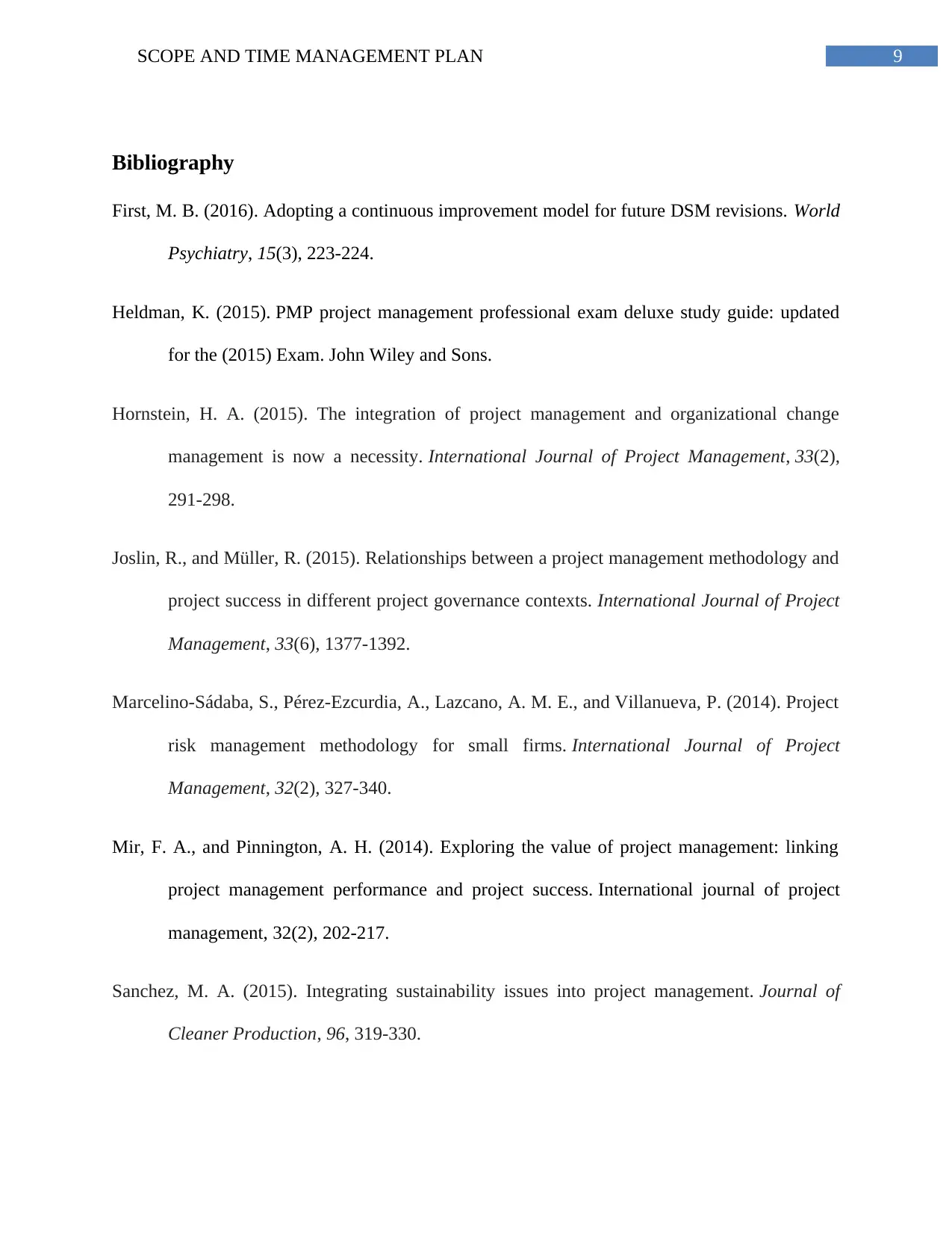
9SCOPE AND TIME MANAGEMENT PLAN
Bibliography
First, M. B. (2016). Adopting a continuous improvement model for future DSM revisions. World
Psychiatry, 15(3), 223-224.
Heldman, K. (2015). PMP project management professional exam deluxe study guide: updated
for the (2015) Exam. John Wiley and Sons.
Hornstein, H. A. (2015). The integration of project management and organizational change
management is now a necessity. International Journal of Project Management, 33(2),
291-298.
Joslin, R., and Müller, R. (2015). Relationships between a project management methodology and
project success in different project governance contexts. International Journal of Project
Management, 33(6), 1377-1392.
Marcelino-Sádaba, S., Pérez-Ezcurdia, A., Lazcano, A. M. E., and Villanueva, P. (2014). Project
risk management methodology for small firms. International Journal of Project
Management, 32(2), 327-340.
Mir, F. A., and Pinnington, A. H. (2014). Exploring the value of project management: linking
project management performance and project success. International journal of project
management, 32(2), 202-217.
Sanchez, M. A. (2015). Integrating sustainability issues into project management. Journal of
Cleaner Production, 96, 319-330.
Bibliography
First, M. B. (2016). Adopting a continuous improvement model for future DSM revisions. World
Psychiatry, 15(3), 223-224.
Heldman, K. (2015). PMP project management professional exam deluxe study guide: updated
for the (2015) Exam. John Wiley and Sons.
Hornstein, H. A. (2015). The integration of project management and organizational change
management is now a necessity. International Journal of Project Management, 33(2),
291-298.
Joslin, R., and Müller, R. (2015). Relationships between a project management methodology and
project success in different project governance contexts. International Journal of Project
Management, 33(6), 1377-1392.
Marcelino-Sádaba, S., Pérez-Ezcurdia, A., Lazcano, A. M. E., and Villanueva, P. (2014). Project
risk management methodology for small firms. International Journal of Project
Management, 32(2), 327-340.
Mir, F. A., and Pinnington, A. H. (2014). Exploring the value of project management: linking
project management performance and project success. International journal of project
management, 32(2), 202-217.
Sanchez, M. A. (2015). Integrating sustainability issues into project management. Journal of
Cleaner Production, 96, 319-330.
Secure Best Marks with AI Grader
Need help grading? Try our AI Grader for instant feedback on your assignments.

10SCOPE AND TIME MANAGEMENT PLAN
Todorovic, M. L., Petrović, D. Č., Mihic, M. M., Obradovic, V. L., and Bushuyev, S. D. (2015).
Project success analysis framework: A knowledge-based approach in project
management. International Journal of Project Management, 33(4), 772-783.
Todorovic, M. L., Petrović, D. Č., Mihic, M. M., Obradovic, V. L., and Bushuyev, S. D. (2015).
Project success analysis framework: A knowledge-based approach in project
management. International Journal of Project Management, 33(4), 772-783.
1 out of 11
Related Documents
Your All-in-One AI-Powered Toolkit for Academic Success.
+13062052269
info@desklib.com
Available 24*7 on WhatsApp / Email
![[object Object]](/_next/static/media/star-bottom.7253800d.svg)
Unlock your academic potential
© 2024 | Zucol Services PVT LTD | All rights reserved.





